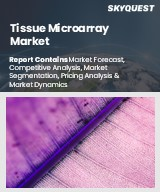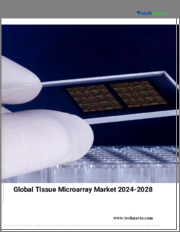
|
시장보고서
상품코드
1770763
조직 마이크로어레이 시장 규모, 점유율, 성장 분석 : 시술별, 기술별, 최종사용자별, 지역별 - 산업 예측(2025-2032년)Tissue Microarray Market Size, Share, and Growth Analysis, By Procedure, By Technology, By End-User, By Region - Industry Forecast 2025-2032 |
||||||
세계의 조직 마이크로어레이 시장 규모는 2023년에 113억 달러로 평가되었으며, 2024년 124억 5,000만 달러에서 2032년에는 270억 8,000만 달러로 성장하여 예측 기간(2025-2032년) 동안 CAGR 10.2%로 성장할 전망입니다.
조직 마이크로어레이 시장은 신약 개발에서의 역할 확대와 제약 및 생명공학 산업의 지속적인 혁신에 힘입어 크게 성장하고 있습니다. 암 발병률의 증가와 정확하고 비용 효율적인 진단에 대한 수요는 이 시장을 더욱 발전시키고 있습니다. 조직 마이크로어레이 기술은 여러 조직 샘플의 고처리량 분석을 가능하게 하며, 연구와 임상 진단 모두에 필수적인 것으로 입증되고 있습니다. 바이오마커 검증 및 실험실 비용 절감과 같은 장점으로 인해 의학 연구 및 맞춤형 의료 개발에서 사용이 증가하고 있습니다. 그러나 높은 초기 설정 비용, 양질의 조직 샘플에 대한 접근성 제한, 복잡한 데이터 해석, 숙련된 전문가의 필요성 등의 문제는 특히 자원이 부족한 신흥 시장에서의 시장 확대를 저해할 수 있습니다.
목차
소개
- 조사 목적
- 조사 범위
- 정의
조사 방법
- 정보 조달
- 2차와 1차 데이터 방법
- 시장 규모 예측
- 시장 가정과 제한
주요 요약
- 세계 시장 전망
- 공급과 수요 동향 분석
- 부문별 기회 분석
시장 역학과 전망
- 시장 개요
- 시장 규모
- 시장 역학
- 성장 촉진요인과 기회
- 성장 억제요인과 과제
- Porters 분석
주요 시장 인사이트
- 핵심성공요인
- 경쟁 정도
- 주요 투자 기회
- 시장 생태계
- 시장 매력 지수(2024년)
- PESTEL 분석
- 거시경제 지표
- 밸류체인 분석
- 가격 분석
- 기술 분석
- 사례 연구
조직 마이크로어레이 시장 규모 : 시술별
- 시장 개요
- 면역조직화학
- FISH(Fluorescent In Situ Hybridization)
- ISH(In Situ Hybridization)
- 기타 시술 종류
조직 마이크로어레이 시장 규모 : 기술별
- 시장 개요
- 중합효소 연쇄 반응(PCR)
- 차세대 시퀀싱
- DNA 마이크로어레이
- 기타 기술 종류
조직 마이크로어레이 시장 규모 : 최종사용자별
- 시장 개요
- 제약 및 바이오테크놀러지 기업
- 조사기관
조직 마이크로어레이 시장 규모
- 북미
- 미국
- 캐나다
- 유럽
- 독일
- 스페인
- 프랑스
- 영국
- 이탈리아
- 기타 유럽
- 아시아태평양
- 중국
- 인도
- 일본
- 한국
- 기타 아시아태평양
- 라틴아메리카
- 브라질
- 기타 라틴아메리카
- 중동 및 아프리카
- GCC 국가
- 남아프리카공화국
- 기타 중동 및 아프리카
경쟁 정보
- 상위 5개사의 비교
- 주요 기업의 시장 포지셔닝(2024년)
- 주요 시장 기업이 채용한 전략
- 최근의 시장 동향
- 기업의 시장 점유율 분석(2024년)
- 주요 기업 개요
- 기업 상세
- 제품 포트폴리오 분석
- 기업 부문별 점유율 분석
- 매출 전년비 비교(2022-2024년)
주요 기업 개요
- OriGene Technologies
- ProteoGenex
- PREMIER Biosoft
- Biocompare
- US Biolab
- Arrayit Corporation
- Protein Biotechnologies
- BioCat GmbH
- SunLink Bioscience, Inc.
- Bio SB
결론과 제안
ksm 25.07.23Global Tissue Microarray Market size was valued at USD 11.3 billion in 2023 and is poised to grow from USD 12.45 billion in 2024 to USD 27.08 billion by 2032, growing at a CAGR of 10.2% during the forecast period (2025-2032).
The tissue microarray market is experiencing significant growth, driven by its expanding role in drug discovery and ongoing innovations in the pharmaceutical and biotech industries. The rising incidence of cancer, coupled with the demand for accurate and cost-effective diagnostics, further propels this market forward. Tissue microarray technology enables high-throughput analysis of multiple tissue samples, proving essential for both research and clinical diagnostics. Its advantages, including biomarker validation and cost reduction in laboratory expenses, contribute to its increasing use in medical research and personalized medicine development. However, challenges such as high initial setup costs, limited access to quality tissue samples, complex data interpretation, and the need for skilled professionals may impede market expansion, particularly in developing regions with limited resources.
Top-down and bottom-up approaches were used to estimate and validate the size of the Global Tissue Microarray market and to estimate the size of various other dependent submarkets. The research methodology used to estimate the market size includes the following details: The key players in the market were identified through secondary research, and their market shares in the respective regions were determined through primary and secondary research. This entire procedure includes the study of the annual and financial reports of the top market players and extensive interviews for key insights from industry leaders such as CEOs, VPs, directors, and marketing executives. All percentage shares split, and breakdowns were determined using secondary sources and verified through Primary sources. All possible parameters that affect the markets covered in this research study have been accounted for, viewed in extensive detail, verified through primary research, and analyzed to get the final quantitative and qualitative data.
Global Tissue Microarray Market Segments Analysis
Global Tissue Microarray Market is segmented by Procedure, Technology, End-User and region. Based on Procedure, the market is segmented into Immunohistochemistry, Fluorescence in situ hybridization (FISH), In Situ Hybridization and Other Procedure Types. Based on Technology, the market is segmented into Polymerase Chain Reaction (PCR), Next-Generation Sequencing, DNA Microarray and Other Technology Types. Based on End-User, the market is segmented into Pharmaceutical and Biotechnological Companies and Research Organizations. Based on region, the market is segmented into North America, Europe, Asia Pacific, Latin America and Middle East & Africa.
Driver of the Global Tissue Microarray Market
The Global Tissue Microarray market is significantly driven by the extensive use of tissue microarrays (TMAs) in drug development processes, enabling the simultaneous screening of numerous tissue samples. By facilitating scientists' observations of diverse tissue responses to innovative drug compounds, TMAs play a crucial role in expediting target validation and toxicity assessment. This capability for high-throughput analysis has solidified TMAs as essential tools in the quest to develop safer and more effective therapies, ultimately enhancing the drug discovery pipeline and improving patient outcomes. Thus, their integral function in research and development continues to propel market growth.
Restraints in the Global Tissue Microarray Market
The Global Tissue Microarray market faces significant constraints primarily due to the limited availability of well-preserved, diverse, and standardized tissue samples, which hampers the overall efficiency of microarray techniques. Inconsistent sample quality stemming from variability undermines the accuracy of results and slows down research advancements. This challenge is particularly acute in the context of rare diseases and underrepresented populations, where sourcing reproducible and high-quality tissue samples proves to be a substantial obstacle. The lack of reliable tissue sources directly impacts the reliability of findings and the pace of scientific progress in this field.
Market Trends of the Global Tissue Microarray Market
The Global Tissue Microarray market is poised for significant transformation, driven by the integration of AI and digital pathology technologies. Over the next few years, advancements in automated pattern recognition and predictive modeling will enhance tissue microarray analysis, enabling quicker and more accurate diagnostics. This shift will not only minimize reliance on manual interpretation but will also make tissue microarrays more accessible to smaller hospitals and laboratories, thereby increasing research scalability. As a result, the market is expected to witness a surge in demand, fostering innovation and expanding its applications across diverse biomedical research fields and clinical diagnostics.
Table of Contents
Introduction
- Objectives of the Study
- Scope of the Report
- Definitions
Research Methodology
- Information Procurement
- Secondary & Primary Data Methods
- Market Size Estimation
- Market Assumptions & Limitations
Executive Summary
- Global Market Outlook
- Supply & Demand Trend Analysis
- Segmental Opportunity Analysis
Market Dynamics & Outlook
- Market Overview
- Market Size
- Market Dynamics
- Drivers & Opportunities
- Restraints & Challenges
- Porters Analysis
- Competitive rivalry
- Threat of substitute
- Bargaining power of buyers
- Threat of new entrants
- Bargaining power of suppliers
Key Market Insights
- Key Success Factors
- Degree of Competition
- Top Investment Pockets
- Market Ecosystem
- Market Attractiveness Index, 2024
- PESTEL Analysis
- Macro-Economic Indicators
- Value Chain Analysis
- Pricing Analysis
- Technology Analysis
- Case Studies
Global Tissue Microarray Market Size by Procedure & CAGR (2025-2032)
- Market Overview
- Immunohistochemistry
- Fluorescence in situ hybridization (FISH)
- In Situ Hybridization
- Other Procedure Types
Global Tissue Microarray Market Size by Technology & CAGR (2025-2032)
- Market Overview
- Polymerase Chain Reaction (PCR)
- Next-Generation Sequencing
- DNA Microarray
- Other Technology Types
Global Tissue Microarray Market Size by End-User & CAGR (2025-2032)
- Market Overview
- Pharmaceutical and Biotechnological Companies
- Research Organizations
Global Tissue Microarray Market Size & CAGR (2025-2032)
- North America (Procedure, Technology, End-User)
- US
- Canada
- Europe (Procedure, Technology, End-User)
- Germany
- Spain
- France
- UK
- Italy
- Rest of Europe
- Asia Pacific (Procedure, Technology, End-User)
- China
- India
- Japan
- South Korea
- Rest of Asia-Pacific
- Latin America (Procedure, Technology, End-User)
- Brazil
- Rest of Latin America
- Middle East & Africa (Procedure, Technology, End-User)
- GCC Countries
- South Africa
- Rest of Middle East & Africa
Competitive Intelligence
- Top 5 Player Comparison
- Market Positioning of Key Players, 2024
- Strategies Adopted by Key Market Players
- Recent Developments in the Market
- Company Market Share Analysis, 2024
- Company Profiles of All Key Players
- Company Details
- Product Portfolio Analysis
- Company's Segmental Share Analysis
- Revenue Y-O-Y Comparison (2022-2024)
Key Company Profiles
- OriGene Technologies
- Company Overview
- Business Segment Overview
- Financial Updates
- Key Developments
- ProteoGenex
- Company Overview
- Business Segment Overview
- Financial Updates
- Key Developments
- PREMIER Biosoft
- Company Overview
- Business Segment Overview
- Financial Updates
- Key Developments
- Biocompare
- Company Overview
- Business Segment Overview
- Financial Updates
- Key Developments
- US Biolab
- Company Overview
- Business Segment Overview
- Financial Updates
- Key Developments
- Arrayit Corporation
- Company Overview
- Business Segment Overview
- Financial Updates
- Key Developments
- Protein Biotechnologies
- Company Overview
- Business Segment Overview
- Financial Updates
- Key Developments
- BioCat GmbH
- Company Overview
- Business Segment Overview
- Financial Updates
- Key Developments
- SunLink Bioscience, Inc.
- Company Overview
- Business Segment Overview
- Financial Updates
- Key Developments
- Bio SB
- Company Overview
- Business Segment Overview
- Financial Updates
- Key Developments












